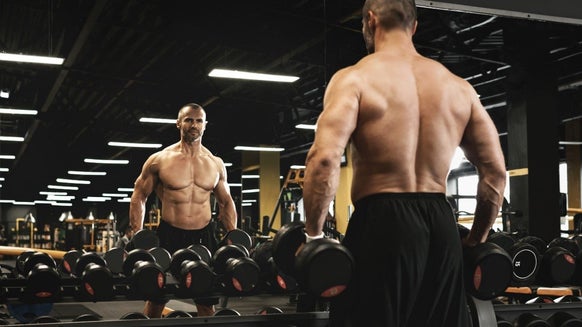
When looking to develop that overall rounded, well-shaped chest area; the first exercise people will refer to is the Flat Barbell Bench Press, and rightly so! The flat barbell bench press is a beneficial staple chest movement for those looking to build size, strength or power in the upper body region. However, all too often; variations of this movement are ignored in the gym in favour of the flat bench!
The decline bench press is an effective flat bench alternative that will change the angle and tension placed on the chest; increasing the likelihood of new stimulus to the working muscle and therefore also increasing the chances of muscle growth. Which muscles does the decline barbell press target?
The decline bench press targets your lower chest: Studies have shown the decline bench press to be an effective exercise for those looking to improve the typically stubborn lower section of the chest (the pectoralis major), which is often neglected, as there are only a handful of exercises which target this area.What are the benefits compared to a flat bench press?
No back stress
When using the flat bench press, we sometimes arch the back in order to shift more weight. For those looking to make an aesthetic improvement to their chest, this will do very little to your chest and instead, it will shift the tension from your chest to your lower back and could also increase the likelihood of an injury. Due to the lowered positioning of the decline barbell bench press; the ability to lift and arch your back is eradicated and therefore there is less potential stress placed on the back, creating a safer lifting experience.More weight
Because of the angle and positing of the decline bench, you’re able to safely increase the weight that you perform the exercise with. In turn, this increase in resistance will shock and stimulate the larger fibres of the pectorals respectively and as a result, this will stimulate them to grow over time. However, it must be noted that, when this weight is being regularly increased over time, anyone performing the exercise should have a Training Partner/PT/General Spotter overlooking them at all times for safety and serious injury prevention.Setting up your bench
Before even positioning yourself on the bench, a thorough warm-up should take place. Be sure to actively stretch out the muscles you’ll be recruiting throughout this movement as well as some rotator cuff movements.It is also advisable to perform a warm-up set before this exercise, using just the bar, to take you cognitively and physically through the movements.For a decline bench press, your bench should be at 15-30 degree angle. At this angle, you will be activating the lower chest (pec major) as you push the weights away from your torso.Your feet should be placed under the support at the end of the bench to help keep them in place.Apply a grip that suits you best (preference is key, but most apply a medium width), whilst keeping your body straight and controlled.Un-rack the barbell and position the bar just above your chest.How to do the Decline Bench Press
Because of the unusual positioning of this bench press variation, it is key that form and technique are correct throughout the movement. Below is a step-by-step guide on how to perform this exercise effectively and also some common mistakes.- Secure your feet at the end of the bench. Lie down with your eyes under the barbell.
- Grip the bar with your palms facing forward, arms slightly wider than shoulder-width apart.
- Straighten your arms to lift the barbell from the rack. Move it over your shoulders, locking your elbows.
- Whilst inhaling a deep breath, gradually lower the bar down until it touches your chest.
- Pause for a brief second and let the fibres stretch across the chest.
- Exhale and return the bar back to where it started. Throughout this phase of the movement, all the tension should be via your pectorals, with the triceps being the assistance.
- Once you have completed the designated number of repetitions, place the barbell back on the rack and slowly return from the decline position.
- It is recommended that you have a training partner or someone to help you to re-rack the bar due to its awkward positioning.
Smith Machine Decline Bench Press
Using the smith machine will provide stoppers that will offer support if you do not feel confident and new to the movement. It is also a fixed machine which will keep the bar stable during the movement.Common Mistakes
Bouncing The Bar Off The Chest
Generally, because we are able to add more weight than usual to the decline bench press, the form and range of motion (Next Point) is ignored and thrown out the gym window. People might bounce the bar off their chest in order to add momentum to the increased resistance they are pushing.Not only will this increase the probability of a sternum injury, but it will also take away any chance of time under tension. Time under tension is what is going to stimulate the chest to grow and if this is ignored then you can forget any chance of improvements in the chest area.Lack of Full Range of Motion
Following on from this, when increased weight is added to the equation; a range of motion is often difficult to complete. Not only will this range of motion create tension across the pectoral muscle fibres; but it will also reduce injury likelihood, help with daily functionality and also benefit the joints surrounding the muscles. To prevent this lack of Range of Motion, select a weight with which you can perform the whole concentric/eccentric movement throughout. If it helps, use a spotter to correct your technique.Improper Breathing
Push movements such as the shoulder press, bench press, military press as well as any other exercises for that matter; are greatly complimented in efficiency when a proper breathing method is applied from start to finish. Breathing properly (inhaling on the eccentric and exhaling on the concentric) will not only lead to increased exercise efficiency but will also allow greater exertion on typically different movements as well as an interlinking relationship with the tempo of the exercise itself. For example, a deep slow breath on the slow eccentric and a powerful exhaling breath out on the concentric.
Not using a Spotter
As previously mentioned, as well as the exercise itself being in an unusual position; re-racking the barbell can be extremely awkward especially with an added onset in muscular fatigue. Failure to re-rack the weight securely will lead to severe injury and also the potential to be put off this exercise for life! As you have seen the benefits of the exercise in the foregone passage; it’s safe to say that you don’t want this to happen! In order to prevent this, ask your training partner or anyone on the gym floor with a sound training knowledge such as a PT to help you throughout the whole exercise, from the lift-off at the beginning all the way to the end.Take Home Message
The lower part of the chest is a stubborn area to hit so if you find a plateau in your chest physique, the decline chest press will soon change that for you.Our articles should be used for informational and educational purposes only and are not intended to be taken as medical advice. If you're concerned, consult a health professional before taking dietary supplements or introducing any major changes to your diet. Chris is a Level 3 personal trainer with a BA Honours degree in Sports Coaching and Development and a Level 3 qualification in Sports Nutrition. With 15 years of experience in the fitness industry, he creates tailored fitness programmes and classes for a wide range of clients, from beginners to advanced athletes. Chris is also a qualified football coach, providing high-level goalkeeping and fitness training at semi-professional level. He spends his free time with his family or training in the gym.









